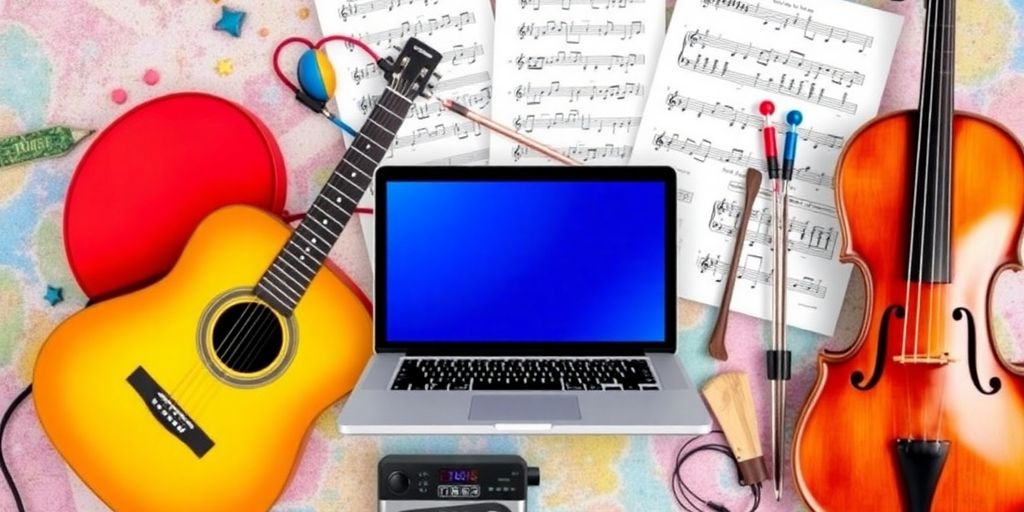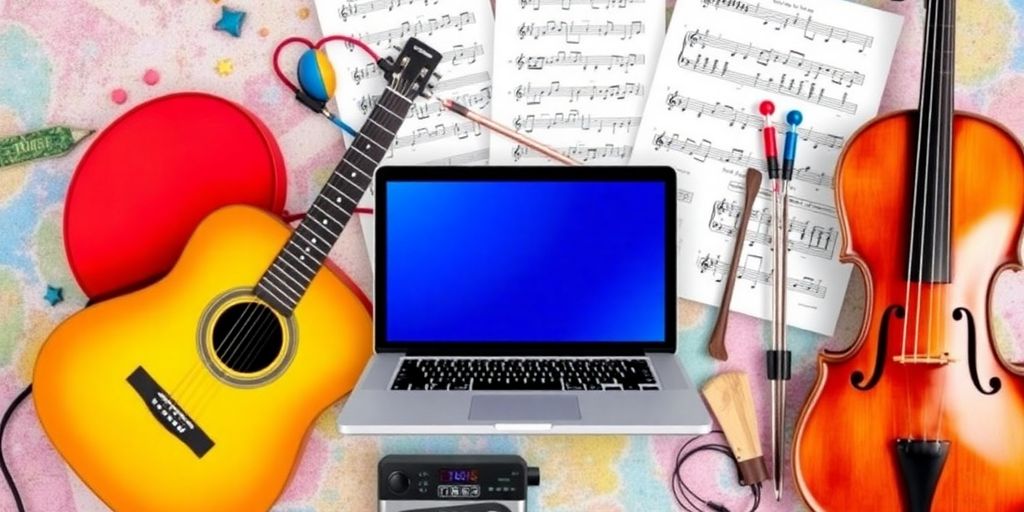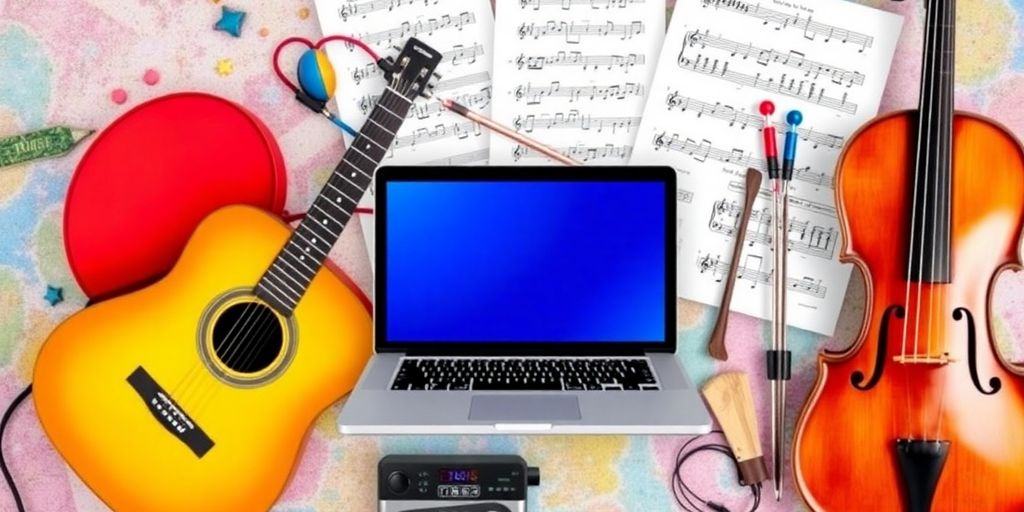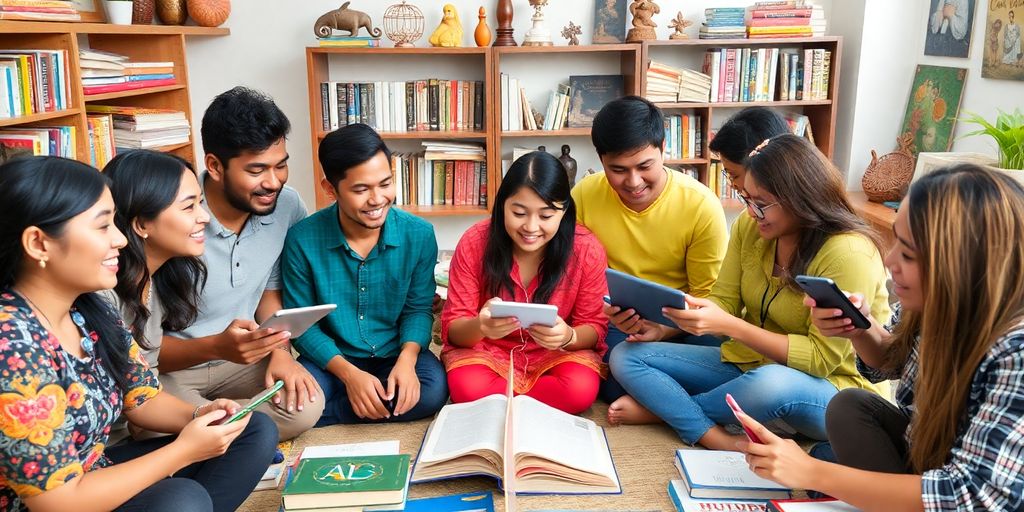Traditional Music Lessons Alternatives: Online Resources & Self-Teaching

Learning to play an instrument can feel overwhelming at first, but the rewards can be significant. Music not only boosts your memory but can also improve your math skills and help you make new friends. While traditional lessons are great, they can be pricey and not everyone has access to them. Luckily, there are plenty of alternatives out there. In this article, we’ll explore various ways to learn music through self-teaching and online resources, giving you the tools to make progress on your musical journey.
Key Takeaways
- Self-teaching offers flexibility and can be cost-effective.
- YouTube is a treasure trove of tutorials and tips for all skill levels.
- Online courses can provide structured learning paths.
- Connecting with fellow musicians online can enhance your learning experience.
- Balancing self-study with occasional professional guidance can lead to better results.
Exploring Self-Teaching Methods
So, you’re thinking about teaching yourself music? Awesome! It can be a really rewarding experience, but it’s also good to know what you’re getting into. It’s not always easy, but with the right approach, you can definitely make progress. I’ve been messing around with instruments for years, and I’ve found that a mix of self-teaching and getting help when I’m stuck works best for me. Let’s look at some ways to get started.
Benefits of Self-Guided Learning
One of the biggest perks of teaching yourself is the freedom it gives you. You get to decide what you want to learn and when you want to learn it. No one is telling you what to do, and you can go at your own pace. This can be really motivating, especially if you’re learning for fun. Plus, you develop a sense of independence and problem-solving skills that are super useful in other areas of life too. I remember when I first started learning guitar, I spent hours just figuring out how to play my favorite songs. It was frustrating at times, but so satisfying when I finally got it right.
Utilizing Online Platforms
YouTube, online courses, apps – the internet is overflowing with resources for self-taught musicians. The trick is to find what works for you. Some people love structured courses, while others prefer to jump around and learn bits and pieces from different places. I’ve found that YouTube is great for learning specific techniques, like how to do a certain guitar riff or how to properly hold a drumstick. Online courses can give you a more complete foundation, and apps can be helpful for practicing and tracking your progress. Don’t be afraid to experiment and see what clicks.
Creating a Structured Practice Routine
Okay, this is where things can get tricky. It’s easy to get excited and want to play all the time, but without some structure, you might not make as much progress as you’d like.
Here’s what I try to do:
- Set specific goals: What do you want to achieve this week? This month?
- Break down your practice: Focus on small chunks of material.
- Be consistent: Even 15-30 minutes a day is better than a long session once a week.
It’s easy to get discouraged if you don’t see results right away, but stick with it. Consistency is key. Think of it like building a house – you need to lay the foundation before you can start putting up the walls.
Leveraging Online Resources
Online resources have revolutionized how we learn music. It’s not just about replacing traditional lessons, but about supplementing them and creating a more personalized learning experience. The sheer volume of material available can be overwhelming, but with a bit of focus, you can find exactly what you need to improve your skills.
YouTube as a Learning Tool
YouTube is a treasure trove for musicians. It’s a great place to find free lessons, tutorials, and performances. You can find channels dedicated to specific instruments, genres, or techniques. The key is to be selective and find instructors whose teaching style resonates with you. Don’t be afraid to experiment with different teachers until you find the right fit. You can replay lessons as many times as you need, which is a huge advantage. For example, if you’re struggling with a particular guitar riff, you can watch a guitar tutorial over and over until you nail it.
Online Courses and Tutorials
Beyond YouTube, many platforms offer structured music courses. These courses often provide a more comprehensive learning path than individual YouTube videos. Some are free, while others require a subscription or one-time payment. Platforms like Coursera, Udemy, and Skillshare have a wide range of music courses taught by experienced instructors. These courses often include assignments, quizzes, and feedback, which can help you stay motivated and track your progress.
Music Apps for Practice
Music apps can be incredibly helpful for practicing and improving your skills. There are apps for everything from ear training to sight-reading to learning scales and chords. Some popular apps include:
- Ear training apps: Help you develop your ability to recognize intervals, chords, and melodies by ear.
- Metronome apps: Essential for developing a solid sense of timing.
- Tuning apps: Ensure your instrument is always in tune.
- Sheet music apps: Provide access to a vast library of sheet music.
Using these apps regularly can significantly improve your musicality and technique. They offer a convenient and engaging way to practice, and many provide personalized feedback to help you identify areas for improvement.
Engaging with Community Learning
It’s easy to get stuck in your own head when you’re learning music by yourself. That’s where community learning comes in! Connecting with other musicians can give you new perspectives, motivation, and a whole lot of fun. It’s about finding your tribe and growing together.
Joining Online Music Forums
Online music forums are like virtual coffee shops for musicians. You can ask questions, share your progress, and get feedback from players of all levels. It’s a great way to troubleshoot problems and discover new music. Plus, you can find people who share your specific interests, whether it’s bluegrass banjo or death metal guitar.
Participating in Virtual Jam Sessions
Virtual jam sessions have become super popular, and for good reason. They let you play with other musicians from all over the world without leaving your house. It can be a little awkward at first, but once you get the hang of it, it’s an awesome way to improve your timing and learn how to play with others. You’ll need a decent internet connection and maybe some special software, but it’s worth it.
Finding Local Music Groups
Don’t underestimate the power of connecting with musicians in your own community. Local music groups, whether they’re formal bands or just casual jam circles, offer a chance to play in person, build real relationships, and support the local music scene. Check community centers, music stores, and local listings to find groups near you. Playing with others in person is a different experience than online, and it can really boost your confidence and skills.
Being part of a music community can keep you motivated and inspired. It’s easy to get discouraged when you’re learning alone, but having other people to share the journey with makes all the difference. Plus, you never know what opportunities might come your way through networking with other musicians.
Incorporating Technology in Learning
Technology has really changed how we learn music. It’s not just about replacing teachers, but more about adding tools to your musical toolbox. I remember when I first started playing guitar, I had to rely on books and my teacher’s ear. Now, there are apps that can tell you if you’re even slightly out of tune! It’s wild.
Using Music Software and Apps
Music software and apps can be game-changers for learning. There are so many options now, from notation software to digital audio workstations (DAWs). I use a DAW to compose songs, and it’s amazing how quickly you can put ideas together. Apps like GarageBand are great for beginners, while more advanced software like Ableton Live or Logic Pro X offer deeper control. You can even find apps that help you practice specific techniques, like scales or chord progressions. It’s like having a personal tutor in your pocket. For example, you can use music notation software to write down your compositions.
Recording and Analyzing Your Playing
Recording yourself is one of the best ways to improve. It can be painful to listen back at first, but you’ll quickly notice things you wouldn’t otherwise.
Here’s a simple process:
- Record a practice session.
- Listen back critically, noting areas for improvement.
- Focus on one or two specific issues in your next practice.
- Repeat the process regularly.
I use a simple USB microphone and Audacity (it’s free!) to record myself playing guitar. Then, I listen back and try to identify areas where I’m rushing or not quite in tune. It’s not always fun, but it’s effective.
Interactive Learning Tools
Interactive learning tools can make practice more engaging. There are apps that provide real-time feedback on your playing, games that teach music theory, and virtual instruments that let you experiment with different sounds. I’ve been using an app that shows me where my fingers should be on the fretboard, and it’s helped me learn new chords much faster. It’s like a video game, but you’re actually learning something useful. Plus, many of these tools offer personalized learning paths, adapting to your skill level and goals.
Technology offers incredible opportunities for self-directed music learning. However, it’s important to use these tools wisely and not rely on them exclusively. A balanced approach, combining technology with traditional methods, is often the most effective way to learn.
Studying Influential Musicians
It’s easy to get caught up in scales and exercises, but don’t forget the inspiration! One of the best ways to improve your playing is to study the musicians who inspire you. It’s like learning from the masters, even if you’re doing it from your bedroom.
Analyzing Performances
Watching and listening closely to your favorite musicians can reveal a lot about their technique and style. Don’t just passively listen; actively analyze what they’re doing. Pay attention to their phrasing, their tone, and how they interact with other musicians. Try to break down their solos into smaller, manageable parts. It’s like reverse-engineering their genius!
Learning from Masterclasses
Masterclasses are a goldmine of information. Many famous musicians offer online or in-person masterclasses where they share their knowledge and experience. These classes often provide insights into their creative process, practice habits, and performance techniques. It’s a chance to learn directly from the best, and often, you can find music and books that they recommend.
Transcribing Songs
Transcribing songs – writing down the notes and chords of a song by ear – is a challenging but incredibly rewarding exercise. It forces you to listen very carefully and develop your ear training skills. Start with simple songs and gradually work your way up to more complex pieces. You’ll gain a deeper understanding of music theory and how different elements fit together. Plus, you’ll have a written record of your favorite songs that you can use for practice or performance.
Studying influential musicians isn’t just about copying their style; it’s about understanding their approach to music and incorporating those elements into your own playing. It’s about finding your own voice through the voices of others.
Here’s a simple way to approach transcribing:
- Choose a short section of a song (e.g., a solo or a verse).
- Listen to it repeatedly, focusing on the melody or chords.
- Try to identify the notes or chords by ear.
- Write them down using standard notation or chord symbols.
- Check your transcription against the original recording and make corrections as needed.
Balancing Self-Teaching with Professional Guidance
Self-teaching music can be awesome, giving you freedom and control. But sometimes, you hit a wall. That’s where a teacher can really help. It’s not about ditching the self-teaching, but finding a good balance.
When to Seek Professional Help
Okay, so you’re rocking the self-taught musician thing, but how do you know when it’s time to call in the pros? Here are a few signs:
- You’re stuck in a rut and not improving, no matter how much you practice.
- You’re developing bad habits that are hard to break.
- You have specific goals (like acing an audition) that require expert guidance.
- You’re feeling lost and overwhelmed by the amount of information out there.
Think of a teacher as a guide, not a crutch. They can offer personalized feedback and help you avoid common pitfalls that self-taught musicians often encounter. It’s like having a GPS for your musical journey.
Combining Online and In-Person Lessons
Who says you have to pick one? Online resources are great for learning at your own pace, but in-person lessons offer something different. The best approach might be a mix of both. Use online tutorials to learn new songs or techniques, and then bring them to your teacher for feedback. This way, you get the flexibility of self-teaching with the personalized attention of a pro.
The Role of Feedback in Learning
Feedback is super important. It’s hard to spot your own mistakes, especially when you’re just starting out. A teacher can give you objective feedback on your technique, timing, and musicality. This isn’t just about pointing out what you’re doing wrong; it’s about helping you understand why and how to fix it. Constructive criticism can be tough to hear, but it’s essential for growth.
Here’s a simple table to illustrate the benefits of feedback:
| Type of Feedback | Source | Benefit |
|---|---|---|
| Technical | Teacher | Corrects posture, hand position, etc. |
| Musical | Peers/Teacher | Improves phrasing, dynamics, expression |
| Performance | Audience | Gauges audience engagement, stage presence |
Setting Realistic Goals and Milestones
It’s easy to get lost in the vast world of music learning, especially when you’re going it alone. That’s why setting clear, achievable goals is super important. It keeps you motivated and helps you see how far you’ve come. Think of it like this: you wouldn’t start a road trip without knowing where you’re going, right? Same goes for music!
Defining Your Musical Objectives
First things first, figure out what you actually want to achieve. Do you dream of shredding guitar solos, composing your own songs, or just being able to play a few chords around a campfire? Your goals should be specific, measurable, achievable, relevant, and time-bound (SMART). Instead of saying "I want to be a good guitarist," try "I want to learn three new chords each month for the next six months."
Tracking Progress Over Time
Once you’ve set your goals, keep track of your progress. This doesn’t have to be complicated. A simple notebook, a spreadsheet, or even a note on your phone can work wonders. Write down what you practice, how long you practice, and how you feel about your progress. Consider recording yourself playing every few weeks. It can be painful to listen back to, but it’s a great way to hear how you’re improving. It’s also important to find local music groups to get feedback.
Celebrating Small Achievements
Don’t forget to celebrate your wins, no matter how small! Did you finally nail that tricky chord change? Reward yourself! Did you manage to practice every day for a week? Awesome! Recognizing your achievements keeps you motivated and makes the whole process more enjoyable. It’s easy to get discouraged when you’re self-teaching, so make sure you acknowledge your hard work. Maybe treat yourself to some new sheet music, a music app for practice, or even just a relaxing evening listening to your favorite tunes.
Remember, learning music is a marathon, not a sprint. There will be times when you feel like you’re not making progress, and that’s okay. Just keep practicing, keep setting goals, and keep celebrating your achievements. You’ll get there eventually!
Wrapping It Up
In the end, whether you choose to learn music through traditional lessons or dive into self-teaching with online resources, it all comes down to what works best for you. There are tons of free options out there, like YouTube, that can help you get started without breaking the bank. Sure, having a teacher can make a big difference, especially for feedback and guidance. But if that’s not in the cards for you, don’t sweat it! With some dedication and the right resources, you can definitely make progress on your own. Just remember, the most important thing is to enjoy the journey and keep playing!
Frequently Asked Questions
What are the benefits of self-teaching music?
Self-teaching allows you to learn at your own pace, choose what you want to learn, and save money on lessons.
How can I use online platforms to learn music?
You can find many free resources on platforms like YouTube, where teachers share lessons and tips for various instruments.
What should I include in my practice routine?
A good practice routine should include warm-ups, learning new pieces, and reviewing what you’ve already learned.
Are there online courses for learning music?
Yes, there are many websites offering structured online courses that teach different instruments and styles.
How can I connect with other musicians online?
You can join online forums, participate in virtual jam sessions, or find local music groups through social media.
When should I consider taking professional lessons?
If you feel stuck, need guidance on technique, or want to improve faster, it might be time to seek professional help.





Responses